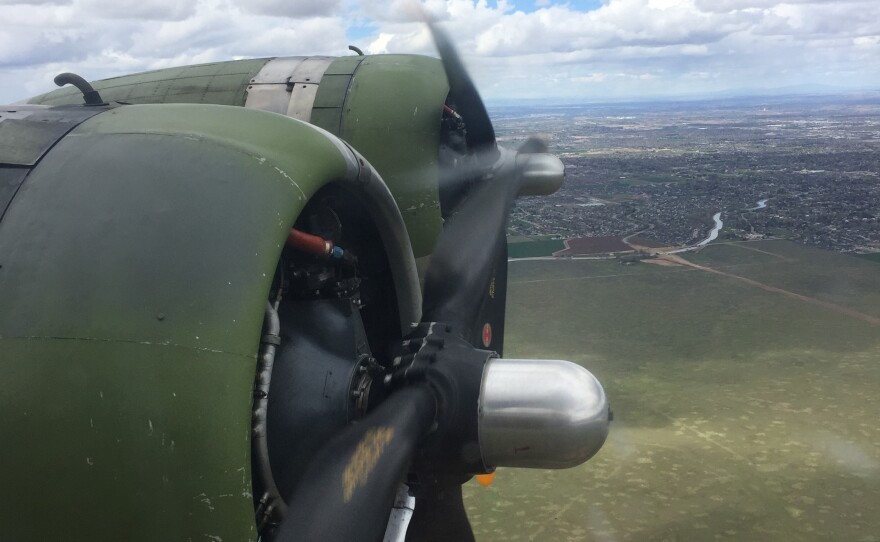This weekend, the skies above Boise will hum with the drone a B-17 Flying Fortress.
The workhorse bomber of World War II, the plane will be open for tours – and flights – April 21 and 22. I was aboard for a preview flight and couldn’t help thinking back to my grandpa’s military career.
He enlisted in the Air Force before it was even established; when he signed up in the late 1930s, he joined the Army Air Corps. World War II was spent in the European Theater. He told stories of raids and victories along with crashes and danger. Having my grandfather as a primary source certainly brought the war into sharper focus. But with more than 70 years between the end of the war and today, the era is increasingly receding from memory into history.
Newsreels from the time provide something of a contemporary glimpse at the war effort in the 1940s. One short clip from the period, replete with stirring patriotic music and a booming announcer, shouts: “B-17s from Seattle, Wichita, Long Beach and the Vega Works in California,” as a montage of planes flashes by. “Flying Fortresses to us, but ‘Baby Doll,’ ‘Yankee Doodle’ or perhaps a significant name such as ‘Birmingham Blitzkrieg’ to the men who fly them.”
Soaring over the Treasure Valley this weekend will be the “Madras Maiden,” which was built in 1944.
Ray Fowler, the chief pilot with the Liberty Foundation, says the Boeing B-17 is the most famous military plane ever built. “They built just short of 13,000, actually 12,732, and now there’s 13 of them flying worldwide,” he says.
The nonprofit Liberty Foundation tours around the country with the plane – and a mission to keep the Flying Fortress functioning.
“It’s really about just keeping the airplane out of a museum, keep it flying,” says Fowler. “So many static museums you go see the airplanes and you know what they did, but getting on board to go fly and look out the waist gun without getting shot at – kind of reconnect with the people that actually flew these airplanes is just the ultimate history lesson.”

Sitting on a tarmac adjacent to the Boise Airport, the B-17’s shiny silver skin glistens in the dappled sun. It’s smaller than I expected, but the lines and physicality of the airplane are striking. Despite being a war plane, it’s got style.
After Fowler leads a safety talk that puts the kibosh on getting up when the plane is taking off or landing, myself and a small group of reporters climb through a small door – it’s more of a hatch, really – at the back of plane and get in.
We strap ourselves in with a rudimentary seatbelt. Fowler, who’s manning the controls in the cockpit, fires up the engines. With a chugging whir and the intoxicating smell of gasoline, the propellors start spinning, and the sound fills the bomber.
Ready for takeoff, I can’t help but think of my grandfather taking a similar seat when heading out on a mission.
The engines of the Madras Maiden rise to a fever pitch. As the old plane hurtles down the runway, airport workers stop what they’re doing and snap photos as we take flight. The four propellors hum, and the Treasure Valley shrinks below.
Flying above Boise, those aboard the Flying Fortress get up and walk through the plane. The waist guns offer the childhood fantasy of defending the Maiden from enemy fire. A narrow gangplank hangs over the empty bomb bay. And in the very front, under the cockpit, the gun in the nose offers an unobstructed view – and little cover.

When we get back on the ground and crawl out of the plane, Fowler sums up the experience.
“You can look at a B-17 picture in a book and you kind of know what it did, but this is the real deal,” he says. “I mean, to come out and to touch it, to smell it, to hear it, to go on board—to bump your head in it like most people do when they go through it, you know, it’s part of the experience. Just come out and see it for real.”
I’ll never know what it was actually like for my grandpa or the airmen in World War II to cross enemy lines in a bomb-filled plane, but, having taken the flight, I appreciate their accomplishments that much more.
For more local news, follow the KBSX newsroom on Twitter @KBSX915
Copyright 2018 Boise State Public Radio







